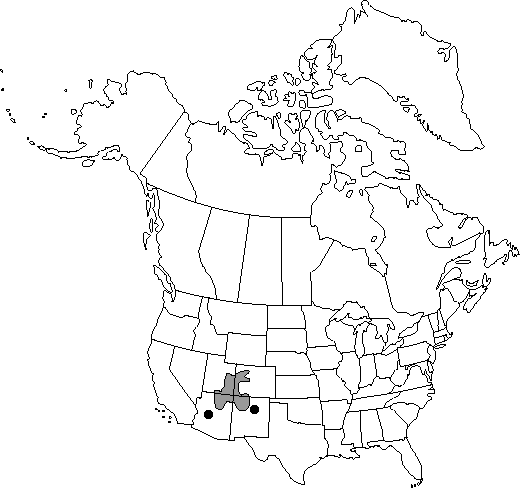Difference between revisions of "Ephedra cutleri"
J. Wash. Acad. Sci. 30: 473. 1940.
FNA>Volume Importer |
FNA>Volume Importer |
||
| Line 23: | Line 23: | ||
}}<!-- | }}<!-- | ||
| − | --><span class="statement" id="st- | + | --><span class="statement" id="st-undefined" data-properties=""><b>Shrubs </b>rhizomatous, forming clumps, erect, 0.25–1.5 m, 3–5 m diam. <b>Bark</b> reddish brown, cracked and irregularly fissured. <b>Branches</b> alternate or whorled, rigid, angle of divergence about 25°. <b>Twigs</b> bright green, becoming yellow-green with age, viscid, ridges between longitudinal grooves papillate; internodes 1–5 cm. <b>Terminal</b> buds conic, 1–3 mm. <b>Leaves</b> opposite, 2–5 mm, connate to 1/4–1/2 their length; bases thickened, brown, persistent; apex setaceous. <b>Pollen</b> cones 2–several at node, obovoid, 4–6 mm, on very short, scaly peduncles (rarely sessile); bracts opposite, 5–9 pairs, light yellow, ovate, 2–4 × 2–3 mm, membranous, slightly connate at base; bracteoles slightly exceeding bracts; sporangiophores 2–4 mm, barely exserted, with 5–7 sessile to short-stalked (less than 1 mm) microsporangia. <b>Seed</b> cones 2–several at node, obovoid to nearly globose, 7–15 mm, peduncles 5–25 mm, with 1 pair of basal and 1 pair of nearly terminal bracts; bracts opposite, 3 or 4 pairs, ovate, 3–6 × 2–5 mm, membranous, with yellow center and base, margins entire. <b>Seeds</b> 2, ellipsoid, 5–8 × 2–4 mm, brown to chestnut, smooth.</span><!-- |
-->{{Treatment/Body | -->{{Treatment/Body | ||
| + | |phenology=Coning late winter–midspring (Mar–May). | ||
|habitat=Dry, flat, sandy areas, occasionally on rocky slopes | |habitat=Dry, flat, sandy areas, occasionally on rocky slopes | ||
|elevation=1400–2300 m | |elevation=1400–2300 m | ||
| Line 45: | Line 46: | ||
|basionyms= | |basionyms= | ||
|family=Ephedraceae | |family=Ephedraceae | ||
| + | |phenology=Coning late winter–midspring (Mar–May). | ||
|habitat=Dry, flat, sandy areas, occasionally on rocky slopes | |habitat=Dry, flat, sandy areas, occasionally on rocky slopes | ||
|elevation=1400–2300 m | |elevation=1400–2300 m | ||
| Line 52: | Line 54: | ||
|publication year=1940 | |publication year=1940 | ||
|special status= | |special status= | ||
| − | |source xml=https://jpend@bitbucket.org/aafc-mbb/fna- | + | |source xml=https://jpend@bitbucket.org/aafc-mbb/fna-data-curation.git/src/9216fc802291cd3df363fd52122300479582ede7/coarse_grained_fna_xml/V2/V2_257.xml |
|genus=Ephedra | |genus=Ephedra | ||
|species=Ephedra cutleri | |species=Ephedra cutleri | ||
| − | |||
| − | |||
| − | |||
| − | |||
| − | |||
| − | |||
| − | |||
| − | |||
| − | |||
| − | |||
| − | |||
| − | |||
| − | |||
| − | |||
| − | |||
| − | |||
| − | |||
| − | |||
| − | |||
| − | |||
| − | |||
| − | |||
| − | |||
| − | |||
| − | |||
| − | |||
| − | |||
| − | |||
| − | |||
| − | |||
| − | |||
| − | |||
| − | |||
| − | |||
| − | |||
| − | |||
| − | |||
| − | |||
| − | |||
| − | |||
| − | |||
| − | |||
| − | |||
| − | |||
| − | |||
| − | |||
| − | |||
| − | |||
| − | |||
| − | |||
| − | |||
| − | |||
| − | |||
| − | |||
| − | |||
}}<!-- | }}<!-- | ||
-->[[Category:Treatment]][[Category:Ephedra]] | -->[[Category:Treatment]][[Category:Ephedra]] | ||
Revision as of 13:15, 27 July 2019
Shrubs rhizomatous, forming clumps, erect, 0.25–1.5 m, 3–5 m diam. Bark reddish brown, cracked and irregularly fissured. Branches alternate or whorled, rigid, angle of divergence about 25°. Twigs bright green, becoming yellow-green with age, viscid, ridges between longitudinal grooves papillate; internodes 1–5 cm. Terminal buds conic, 1–3 mm. Leaves opposite, 2–5 mm, connate to 1/4–1/2 their length; bases thickened, brown, persistent; apex setaceous. Pollen cones 2–several at node, obovoid, 4–6 mm, on very short, scaly peduncles (rarely sessile); bracts opposite, 5–9 pairs, light yellow, ovate, 2–4 × 2–3 mm, membranous, slightly connate at base; bracteoles slightly exceeding bracts; sporangiophores 2–4 mm, barely exserted, with 5–7 sessile to short-stalked (less than 1 mm) microsporangia. Seed cones 2–several at node, obovoid to nearly globose, 7–15 mm, peduncles 5–25 mm, with 1 pair of basal and 1 pair of nearly terminal bracts; bracts opposite, 3 or 4 pairs, ovate, 3–6 × 2–5 mm, membranous, with yellow center and base, margins entire. Seeds 2, ellipsoid, 5–8 × 2–4 mm, brown to chestnut, smooth.
Phenology: Coning late winter–midspring (Mar–May).
Habitat: Dry, flat, sandy areas, occasionally on rocky slopes
Elevation: 1400–2300 m
Distribution

Ariz., Colo., N.Mex., Utah.
Discussion
The hybrid Ephedra × arenicola is discussed under E. torreyana.
Selected References
None.